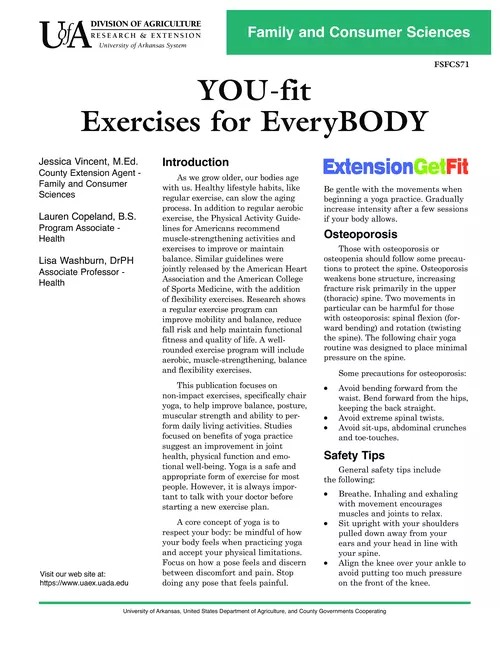
YOU-fit Exercises for EveryBODY, FSFCS71 - UAEX
These exercises have been used in seated exercise classes across the world and have been shown to maintain function and independent living.
adsPart of the document
As we grow older, our bodies age
with us. Healthy lifestyle habits, like
regular exercise, can slow the aging
process. In addition to regular aerobic
exercise, the Physical Activity Guide-
lines for Americans recommend
m uscle-strengthening activities and
exercises to improve or maintain
b alance. Similar guidelines were
jointly released by the American Heart
Association and the American College
of Sports Medicine, with the addition
of flexibility exercises. Research shows
a regular exercise program can
improve mobility and balance, reduce
fall risk and help maintain functional
fitness and q uality of life. A well-
rounded exercise program will include
aerobic, muscle-strengthening, balance
and flexibility exercises.
This publication focuses on
n on-impact exercises, specifically chair
yoga, to help improve balance, posture,
muscular strength and a bility to per-
form daily living a ctivities. Studies
focused on benefits of yoga practice
suggest an improvement in joint
health, physical function and emo-
tional well-being. Yoga is a safe and
appropriate form of exercise for most
people. However, it is always impor-
tant to talk with your doctor before
starting a new exercise plan.
A core concept of yoga is to
respect
your body: be mindful of how
your body feels when practicing yoga
and accept your physical limitations.
Focus on how a pose feels and discern
between discomfort and pain. Stop
doing any pose that feels painful.
ExtensionGetFit
Be gentle with
the movements when
beginning
a yoga practice. Gradually
increase intensity
after a few sessions
if your body allows.
Osteoporosis
Those with osteoporosis or
o steopenia should follow some prec au-
tions to protect the spine. O steoporosis
weakens bone structure, increasing
fracture risk primarily in the upper
(thoracic) spine. Two movements in
particular can be harmful for those
with osteoporosis: spinal flexion (for-
ward bending) and rotation (twisting
the spine). The following chair yoga
routine was designed to place minimal
pressure on the spine.
Some precautions for osteoporosis:
¥Avoid bending forward from the
waist. Bend forward from the hips,
keeping the back straight.
¥Avoid extreme spinal twists.
¥Avoid sit-ups, abdominal crunches
and toe-touches.
Safety Tips
General safety tips include
the
following:
¥Breathe. Inhaling and exhaling
with movement encourages
muscles and joints to relax.
¥Sit upright with your shoulderspulled down away from yourears and your head in line with
your spine.


